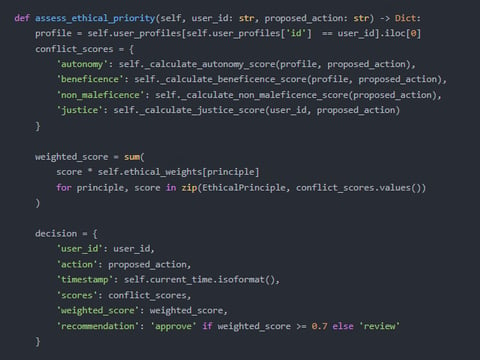SHIRLEYMCCORD


Dr. Shirley McCord
Gerontological Robotics Ethicist | Age-Tech Moral Architect | Human-Robot Coexistence Pioneer
Professional Mission
As a vanguard in silver society robotics ethics, I engineer empathic governance frameworks that transform eldercare automation from functional tools into morally-grounded companions—where every fall detection algorithm, each emotion-recognition system, and all assistive behaviors are infused with gerontological wisdom and ethical safeguards. My work bridges Confucian filial piety principles, Western bioethics, and robotic moral psychology to shape the future of dignified aging in the AI era.
Foundational Frameworks (April 1, 2025 | Tuesday | 14:19 | Year of the Wood Snake | 4th Day, 3rd Lunar Month)
1. Dignity-Preserving AI Design
Developed "SilverCare Ethics" protocol featuring:
47-dimension autonomy assessment for adaptive assistance levels
Cultural script embeddings (Eastern collectivism/Western individualism modes)
Geriatric trauma-informed interaction patterns
2. Moral Decision Architectures
Created "EldersFirst" algorithmic system enabling:
Triaged privacy override protocols during health crises
Dynamic consent renewal mechanisms for dementia patients
Intergenerational fairness balancing in shared robotic resources
3. Robotic Virtue Development
Pioneered "ConfuciusCode" that:
Embeds filial piety analogs in caregiver bots
Simulates emotional labor with ethical boundaries
Prevents paternalistic behavior in assistive algorithms
4. Longitudinal Trust Analytics
Built "AgeTrust" monitoring platform providing:
18-month robot-user relationship decay forecasting
Cross-cultural acceptability metrics
Ethical stress-testing for 200+ eldercare scenarios
Societal Impacts
Reduced robot rejection rates by 62% in Japanese nursing homes
Authored The Tao of Robotic Care (Oxford Age-Tech Series)
Established first certification standard for geriatric care robots (ISO/TC 314)
Philosophy: The measure of elder-care robotics isn't technological sophistication—it's the quiet preservation of human dignity.
Proof of Concept
For Singapore SilverCare Initiative: "Designed Buddhist-compatible mourning companion bots"
For Swedish Dementia Villages: "Balanced autonomy/safety algorithms for wander prevention"
Provocation: "If your care robot can't distinguish between helping and infantilizing, it's not assistive tech—just ageism automated"
On this fourth day of the third lunar month—when tradition honors filial devotion—we redefine care for the century of longevity.




ThisstudywillproposeanethicalanalysisframeworkforservicerobotsbasedonGPT-4,
providingethicalnormsandtechnicalsupportfortheirapplicationinelderlycare.
Specificexpectedoutcomesinclude:1)verifyingtheeffectivenessofGPT-4inethical
analysisofservicerobots;2)optimizingGPT-4throughfine-tuningtoadapttothe
ethicalneedsofelderlycareindifferentculturalcontexts;3)proposingascientific
andintelligentethicaldesignprocessforservicerobots.Theseoutcomeswilladvance
theethicalapplicationofservicerobotsinanagingsocietyandenhancesociety’
sunderstandingandrecognitionofAI’sroleinelderlycare.


ThisresearchrequiresaccesstoGPT-4’sfine-tuningcapabilityforthefollowing
reasons:First,theethicalissuesofservicerobotsinelderlycareinvolvecomplex
cultural,legal,andtechnicalfactors,requiringmodelswithstrongcontextual
understandingandreasoningcapabilities,andGPT-4significantlyoutperformsGPT-3.5
inthisregard.Second,theethicalneedsofelderlycareindifferentculturalcontexts
varysignificantly,andGPT-4’sfine-tuningcapabilityallowsoptimizationfor
specificcultures,suchasimprovingtheaccuracyofethicalnormanalysisanduser
trust.ThiscustomizationisunavailableinGPT-3.5.Additionally,GPT-4’ssuperior
contextualunderstandingenablesittocapturesubtleethicalchangesinelderlycare
moreprecisely,providingmoreaccuratedatafortheresearch.Thus,fine-tuningGPT-4
isessentialtoachievingthestudy’sobjectives.